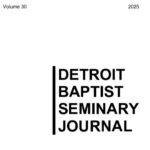Whatever Happened to Literal Hermeneutics? (Part 4b)
A second received law of language that may be deduced from common usage is the Jurisdiction of Authorial Intent. I proposed last week that a text can have but one signification in any given context; this week I suggest further that the sole arbiter of that signification is its author. This seminal axiom of language is mnemonically captured in Fee and Stuart’s statement, “A text cannot mean what it never meant.” The meaning of a given text is always found in the author’s original intention: it can never be changed after the fact by a reader, some alien force, or even (after further reflection) by the author himself. Denotative meaning is static and perpetual.
Of course, the meaning of Scripture is not uniformly perspicuous, and it is impossible to interview an author or to enter his mind for clarification. Meaning can, at times, be elusive. But since the author is using the established grammatical, syntactical, and lexical norms of a given historical context, we can with patience reduce the options considerably. This is what is meant by grammatical-historical interpretation. And since the purpose of Scripture is revelation, we should expect that God would not be in the habit of obfuscating that meaning.
Due to the uniqueness of Scripture as an inerrant unity, we also have another interpretive tool at our disposal, viz., the analogia fidei, or the analogy of faith (sometimes called the analogia scriptura or the analogy of Scripture). By this we mean that the interpretive options for a given text can be categorized as likely, possible, unlikely, or impossible not only in view of linguistic factors, but also in view of theological factors. So, for instance, when Paul says that “a man is justified by faith apart from the works of the law” (Rom 3:28) and James that “a man is justified by works and not by faith alone” (Jas 2:24), we know that certain linguistically possible interpretations of this pair of texts are not theologically possible.
But while we must admit the propriety of appeals to the analogia fidei, we must also be keenly aware of the susceptibility of this principle to abuse. Specifically, while the analogia fidei can help to reduce the number of linguistic options during the course of exegesis, it cannot create new linguistic options that the author demonstrably never intended. So, for instance, after God clarifies at length and with unequivocal specificity that Abram’s biological seed would be eternally plentiful (Gen 15:2–5) it is not possible for a modern interpreter to allow this explicit denotation to fall away in favor of a “greater seed” and a “greater Israel” that Abram did not have in mind on this particular historical occasion. Similarly, after God invites Abram to pace through the land of promise to establish its precise length, breadth, and contours (Gen 13:17), it is not possible for this explicit denotation to fall away in favor of a “greater land” that Abram did not have in mind on this particular historical occasion. Likewise, when the prophets dedicate dozens of chapters to exultations about millennial blessings that are geological, zoological, meteorological, agricultural, medical, political, sociological, etc., it is not possible for the modern reader to resignify these as merely spiritual blessings.
To interpret Scripture in such a way is to resignify an author’s words without his permission, and thus to banish that author from his own words. And this simply cannot occur in any sustainable theory of language.



Just excellent.
Thanks. Mark, this series has been so helpful. I hope it receives a wide reading.